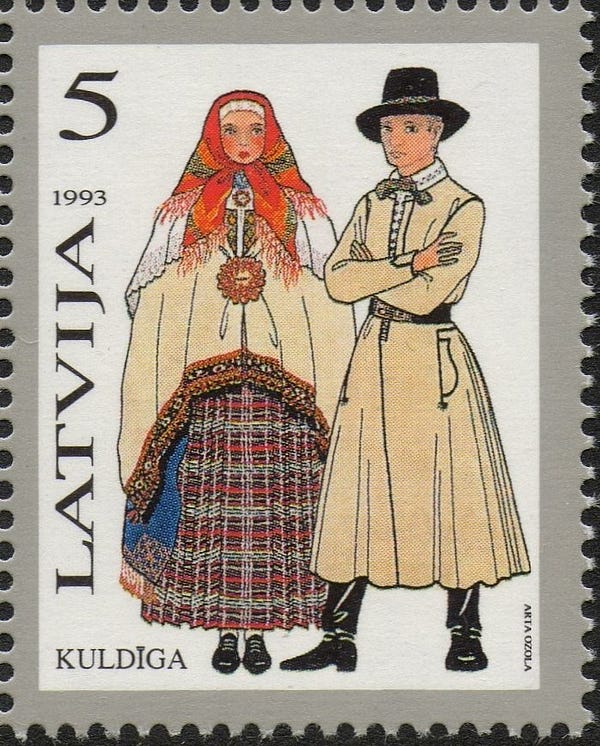Stamp of the Week #2
Traditional Latvian folk dresses
This week’s stamp comes from Latvia, as part of a series on the country’s traditional costumes. Published in 1993, this stamp depicts a traditional costume from the town of Kuldīga, located in the western Kurzeme region of the eastern European country. These traditional dresses and costumes are known for their unique, complex pattern work, consisting of ever-changing geometric designs and traditional ethnographic symbols of health, wealth, and good traits.
The origin of Latvian dresses goes all the way back to the 7th century, where they were worn by the native Baltic and Livonian peoples who lived in the area at the time. Over the centuries the dresses would see major changes in style and design; the modern designs we see today first originated in the 19th century, taking influences from the German culture which was dominant at the time.
A traditional Lativan dress will consist of many layers. The lowest layer is a patternless skirt and a long-sleeved linen shirt. On top of this comes a pleated sewn skirt, a patterned sash (or josta) to secure this sewn skirt, and finally a large woollen shawl known as the villaine. Married women will also wear a crown (vainags) or head-cloth to signify their marital status; in recent times, however, both married and unmarried women have come around to wearing silk scarves over their head in lieu of the crown; the stamp is a good example of this.
The five regions of Latvia—Vidzeme, Kurzeme, Zemgale, Sēlija and Latgale—all have their own variations on the dress. Kurzeme region dresses feature either bright stripes or a monochromatic red depending on the area. In areas closer to the coast, dresses are adorned with bead strings and brooches made from pieces of amber, according to The Latvian Institute. Both men and women will wear bronze belts, as the man portrayed in the stamp does. Differences between regions can be stark; for instance, dresses in the central Zemgale region are worn with a large woven sash, containing vertical stripes in a weft-pattern weave. Skirts are patterned with rose, zigzag, diamond, and triangle motifs in comparison to the more simplistic designs of the Kurzeme region.

These differences, among others, are highlighted and put on display during the quinquennial Lativan Song and Dance Festival, the biggest event in Latvian culture. The first Lativan Song and Dance Festival took place in 1873, during the First Wave of National Awakening the country experience between 1850 and 1880. Today, the festival commemorates the founding of Latvia as a nation and Latvian culture as a unique identity. Over 500,000 revelers and 40,000 performers fill the streets of Riga, the country’s capital, taking place in exhibitions, events, competitions, parades, and as you would expect from its name, songs and dances. Dresses play a role as well, with most—if not everyone—wearing dresses passed down from previous generations or exemplifying their home region. There’s even a costume showcase event, where modelers showcase Latvian fashion designers’ takes and adaptations on the traditional garb.
Some videos documenting the 2018 Song and Dance Festival:
My top 5 songs from latvian song and dance festival 2018 - YouTube
Latvian Song and Dance Festival 2018 - YouTube
XXVI Latvian Nationwide Song and XVI Dance Celebration (2018) - YouTube
I don’t think it’s a coincidence that modern Latvian dresses came into vogue around the same time as the start of the Song and Dance Festival as well as the first push for national independence. Much of Latvia’s history has been spent with the region being occupied by larger powers: the Germans (twice; by the German Empire and the Nazis), the Russians (three times; once by the Russian Empire and twice by the Soviets), the Swedish, among others. In my (very) amateur viewpoint, the dresses provided Latvians a visual standpoint to which they could map and identify their own unique culture and country onto, standing athwart centuries of occupation by greater European powers.


